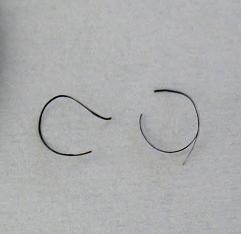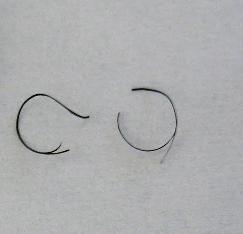@
Nonie - I appreciate your very scientific explanation, and I can see you feel very strongly about your opinion. However, no that isn't the case for ME AND MY HAIR. Breakage is a form of damage so I wasn't saying my hair was perfectly healthy. I'm saying my ends being thin wasn't due to splits. Point blank period.
MINE was mainly due to breakage caused by stretching my relaxers too long. So if my hair breaks along the line of demarcation that means there are not as many strands of hair reaching the very bottom of my length, right? Therefore my ends became thinner as a whole because there was less volume of hair there. Yes, your explanation makes perfect sense - for some. But mine does too, right? If there is more hair near the roots and less at the end due to breakage along my line of demarcation the overall result was hair that appeared thicker at the roots and thinner at the ends.
Breakage for me was also caused by my previous stylist changing relaxers without my knowledge and a couple of other things. The fact that now I'm happily relaxing between 10-12 weeks and stopped visiting the salon altogether also supports MY theory. Thanks for your opinion, lots of good info that I'm sure someone will find valuable

, but I still have to disagree with you. All thin ends are not caused by splits and I'm speaking from my own experience.
You asked what else could it be besides splits? Lots of things can cause breakage at any point along the hair shaft. Dryness, combs with seams, metal pieces on hair accessories, etc. etc. I mean I can appreciate your passion about the research you've done, but I still can't agree that it applies to every head of hair. Sorry OP, didn't mean to jack your thread!!!
OK @
EbonyCPrincess, the part in bold is information you hadn't given before about breakage at the point of demarcation. Ceramide oils do not fix this problem so this would not have been guessed from your post. Also you stated you practiced haircare that causes damage to the structure of hair, so to then say that after that your had no tears, didn't add up.
But even breakage at the demarcation doesn't happen for any other reason than the strands beyond the demarcation are torn up (which starts from splitting) and weakened to a point whereby they are no longer as whole and strong as they used to be so that is why they break off. Splits is how that comes to be.
Anyway, I guess we'll just agree to disagree.
I think Princess and Nonie are taking about two different things, sorry to but in. But I think when Princess says her "ends are thin" she means the density or thickness of the bulk of her hair at the ends... like if she were to braid her hair in to one plait she would have a pretty noticable taper. She mentioned a relaxer thinning her har out like a pair of thinning shears taking out bulk.
While Nonie is talking about the "ends" of each strand being thin... which would also equal taper but not necessarily because of the same thing.
Again sorry to but in but it looked like a mediator might be helpful

excuse my rambling I just got home from a 12 hr shift after 4 hours of sleep. >_<
@
WyrdWay Hair that is breaking past the point of damarcation is usually hair that is badly damaged. Damage involves tearing away of the cuticle exposing the cortex of hair as shown in the photo below; the side closest to us has lost its scales of cuticle:
Then when this continues and the damage worsens the cortex explodes and the strand slowly tears away:
As this happens the hair will break off at the point where that tearing got to, because it doesn't split uniformly all the way to the base, but each arm of the tear tapers and breaks off. All the hair from the ends up to that point is weaker; it's divided and has lost some of its mass. It will look thin. Eventually each of those sections of the strand that were left will break off as they are all weaker than the whole. Throughout this whole process, the hair will look thin. When each arm of the split breaks off, the hair will look thin.
When talking about relaxed hair, this is usually so obvious because there's a difference in texture and the virgin hair is usually in a state of wholeness so breakage will happen at the point of demarcation. With natural hair, there is also a "point of demarcation" where the tearing of the strands reached so that ends also in this case appear thin from breakage happening there. So you see, we're talking about two sides of the same coin. One is chemical damage; one is mechanical damage. Both will lead to damaged strands that will break at the point where the damage has reached. The results are thin ends.
In both cases the thickness of the bulk at the ends will be affected. In both cases if you braid the hair the end will taper. In both cases, hair looks thin as if thinned out by thinning shears. Six of one, half a dozen of the other.
The chemistry of the relaxing process is identical with that of perming, with the breaking of disulphide linkages and re-forming of the hair shape (in a straighter arrangement this time, rather than in curls), followed by re-making of the linkages.
The oval (elliptical) shape and natural crimp of Afro-Caribbean hair makes it difficult to straighten without damage. The chemical treatment can weaken the hair structure, and breakage after relaxation treatment is not uncommon. Contributing factors include incorrect concentrations of relaxing solution, mistakes in timing the application, and incomplete rinsing. Often the hair breakage is seen at the back of the neck. In addition, straightening leaves the hair fibers in a high degree of torsional stress (twisting), and a slightly wavy look. This makes them liable to rapid weathering, with the cuticle wearing down at the ends of the cross-sectional ellipse and a characteristic lengthwise splitting.
(
Source)
This is the kind of damage that is caused to African hair by the use of chemical relaxants
(
Source)
So thin ends, regardless of what caused them are a result of cuticle damage that leads to splitting up of the strand with the tears running up the strand and tearing off after tapering. If ever the phase "United we stand, divided we fall" rang true its in the structure of hair strands. The minute there's a split, there's a weakening. None of those sections have the strength to stick around. Slowly by slowly they will break away and with each loss, ends will look thinner. Eventually the whole strand will break off leaving FEWER strands which don't have a prayer, which will also look thinner and eventually meet their demise. This happens with both natural and relaxed hair, so really we can paint it a different color but it's still going to be a version of the same thing.
ETA: In the last photo showing relaxed hair, you can see that breakage has occurred at one arm of that lengthwise splitting that is inevitable in all hair. Notice how the spliting still continued up the strand which is why letting your hair break on its own instead of you cutting it doesn't solve the problem. But what I really want you to see is that the arm that didn't break is a classic example of a thin end that follows splitting. That arm itself doesn't look split, but does it mean the hair isn't split? No it doesn't. Picture this happening to many strands and you can see how the ends will all look thinner. Now if one arm broke, chances are the other arm will have the same fate so imagine that happening gradually...and the hair itself starts to look thinner at the ends and eventually all break off.
So the two "differences" you pointed out are birds of a feather.








 Switch to a satin scrunchie if you continue to bun. I also found that by tucking my ends and bobby pinning them early in my journey helped my ends very much. And of course, moisturizing and sealing.
Switch to a satin scrunchie if you continue to bun. I also found that by tucking my ends and bobby pinning them early in my journey helped my ends very much. And of course, moisturizing and sealing.
